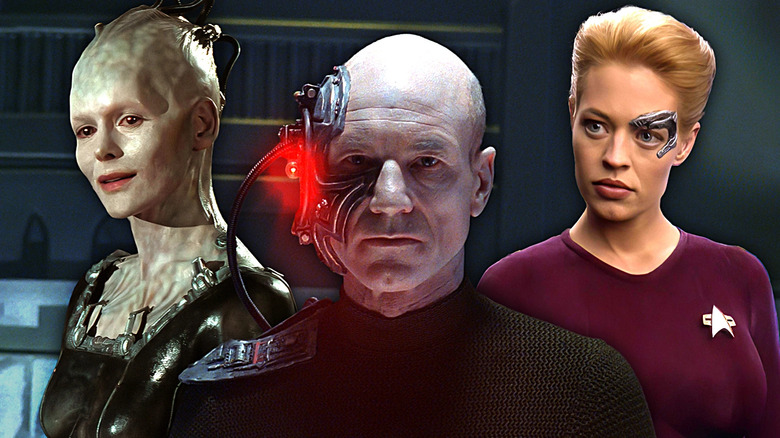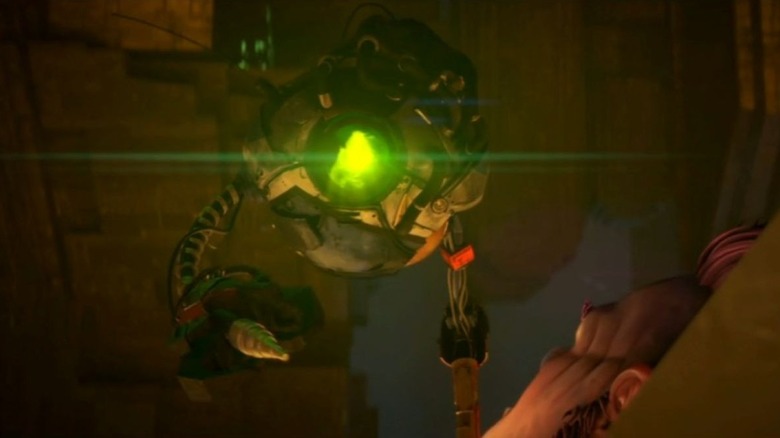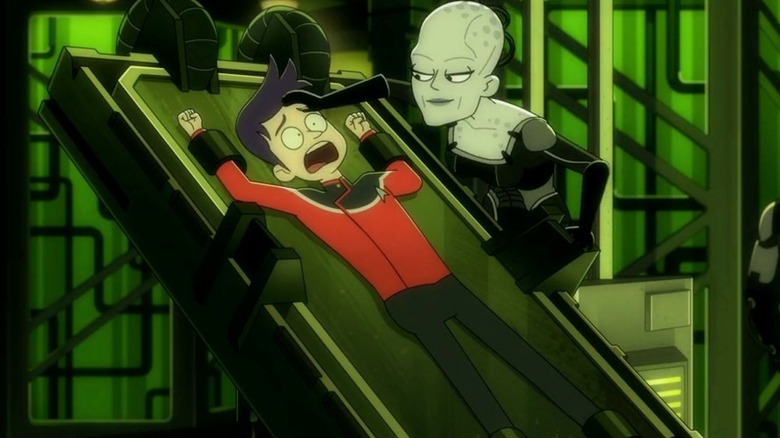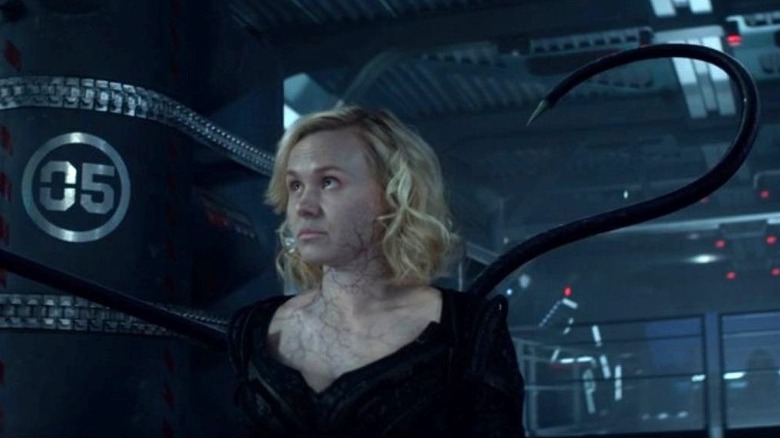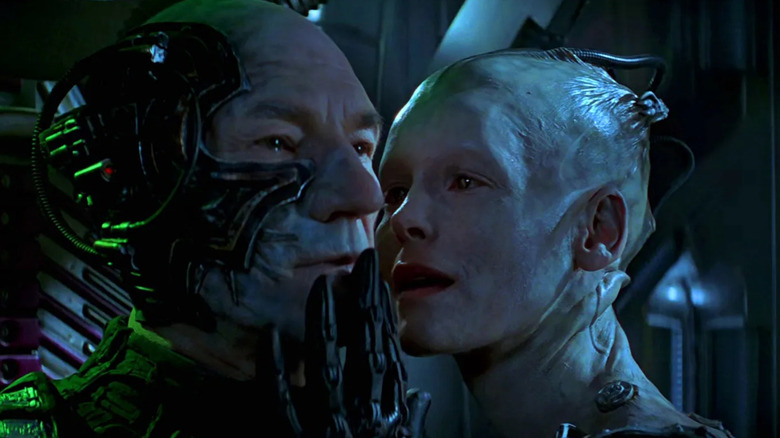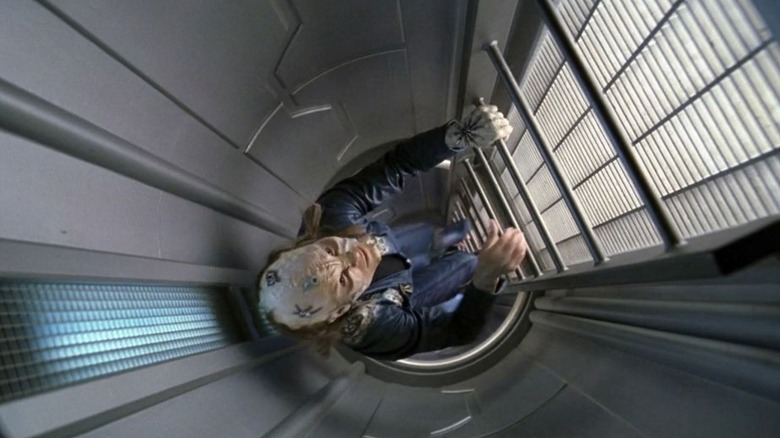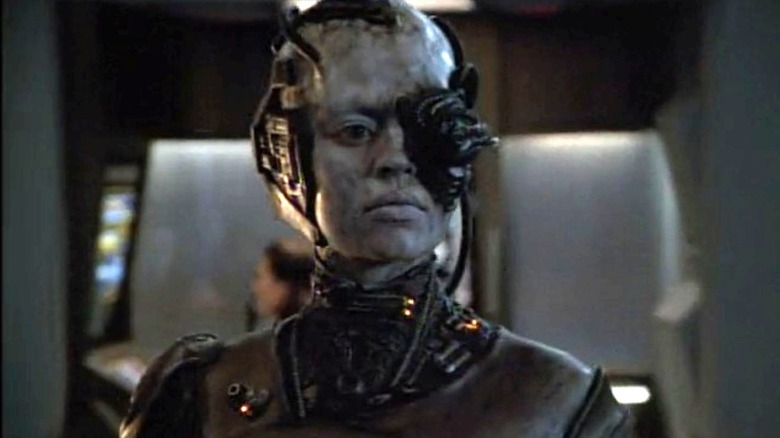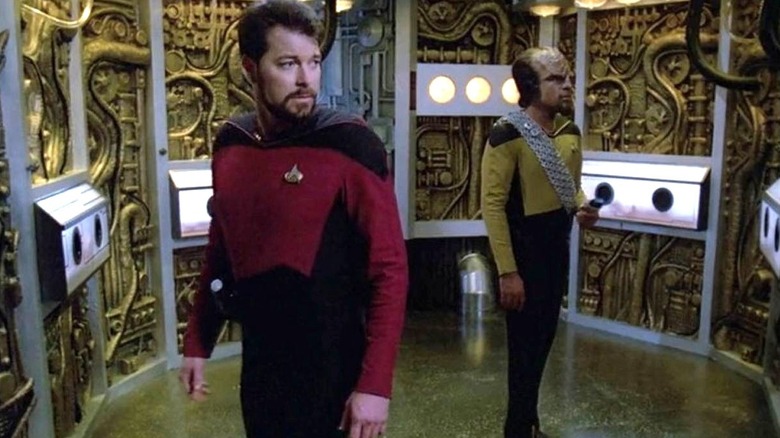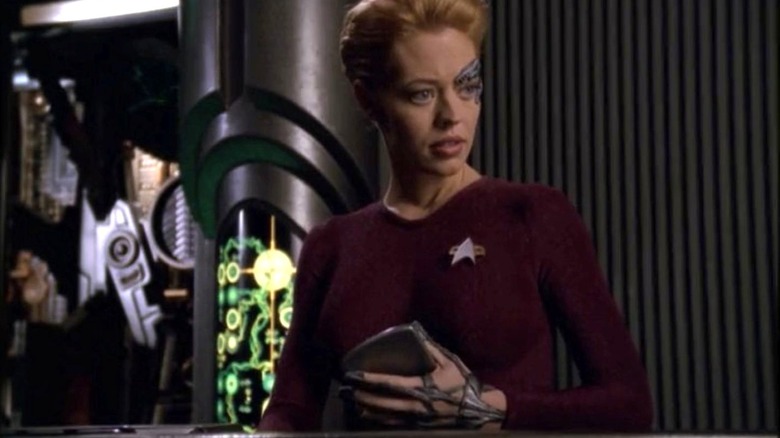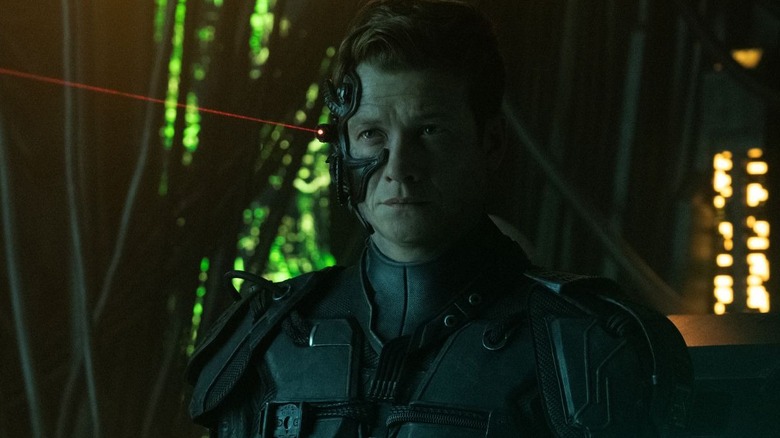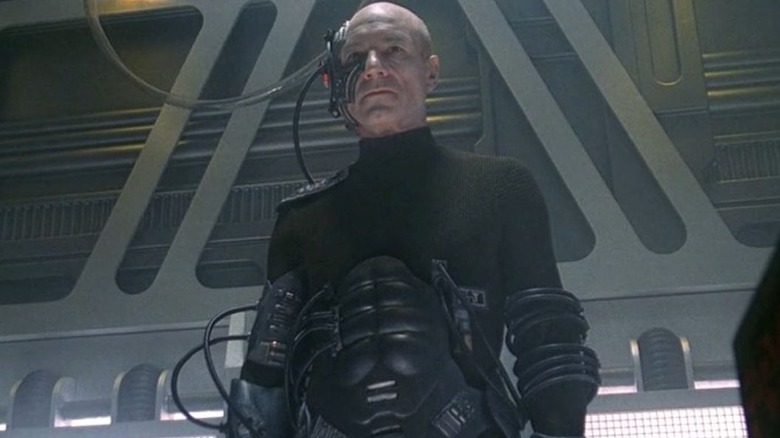Star Trek's 10 Best Borg Stories Ranked
The "Star Trek" universe knows that resistance is futile when it comes to a good Borg story. At times, the Borg have been considered the best "Star Trek" villains, thanks to their ominous presence that comes from emotionless expressions and a collective energy that makes them larger than life. The Borg pursue perfection by absorbing others into their collective, and they even destroy injured Borg in order to ditch imperfections.
A species destroying itself offers a horror element that plays well into the dramatic tone of "Star Trek: The Next Generation," which is the "Star Trek" series that introduces this standout villain. They become a moderately consistent presence in future series, especially "Star Trek: Voyager," which focuses on how a longtime Borg navigates Starfleet life. The Borg's consistent resurgence may feel like an attempt to recycle old material, but that is not the case since each story offers new nuggets that help us understand their mission and their fears.
Their constant evolution is why we're still intrigued by the Borg more than 30 years after their first appearance. That's why we're taking a look at the Borg's 10 best "Star Trek" stories and ranking the ones that assimilated our hearts and minds.
Star Trek: Prodigy - Let Sleeping Borg Lie (Season 1, Episode 12 )
"Star Trek: Prodigy" was created as a point of entry for young viewers, which means that a run-in with the Borg is necessary, especially since it's trying to be the ultimate "Star Trek: Voyager" sequel. While season 1, episode 12, "Let Sleeping Borg Lie," introduces kids to familiar references, it also offers some new tidbits for adults that help us better understand one very important Borg story.
U.S.S. Protostar crewmember Zero (Angus Imrie) joins the Borg to help the crew obtain answers regarding a weapon on their ship. While most assimilations focus on outward changes and conflict, Zero's assimilation focuses on the inner workings of the collective mind as we leave the outside world and go inside the Borg's brain. Zero begs for help as they try to alter their mind. It's an inner experience that helps us understand the type of communication that could have been happening during Jean-Luc Picard's (Patrick Stewart) assimilation in "Star Trek: The Next Generation," which possibly included his own plea for answers while fighting for his humanity.
Like Picard, Zero has a tough time resisting, but the episode uses this conflict to teach viewers a lesson about love and friendship as Gwyn (Ella Purnell) reminds Zero that their inner power is greater than the Borg. A lesson-of-the-week approach is a tried and true children's television formula, but "Star Trek: Prodigy" uses this formula to make a point about how friendship has been the key to Starfleet's consistent defeat of the Borg.
Star Trek: Lower Decks - I, Excretus (Season 2, Episode 8
"Star Trek: Lower Decks" is one of the franchise's best animated series. It pokes fun at this universe while making revelations about some of its biggest moments, and the Borg is no exception. In season 2, episode 8, "I, Excretus," Ensign Brad Boimler (Jack Quaid) must complete a Borg simulation while his crewmates encounter other tests based on past "Star Trek" storylines. He is the only one who is successful on the first go-around, but he keeps repeating the simulation until he reaches a perfect score.
Boimler's unrelenting quest for perfection is a big nod to the Borg, and he uses this quest as a way to prove just how super he can be as he saves Borg babies and even creates a Borg explosion reminiscent of the one in "Star Trek: First Contact." While this scenario is merely a test, Boimler does mention that the Borg took everything from him after his last attempt veers into an assimilation that includes "Star Trek: First Contact" co-star Alice Krige reprising her role as the Borg Queen. A plot twist does suggest that not everything in the test was controlled, and I wouldn't put it past the Borg to connect their collective mind to Brad's test, especially when they realize his determination for perfection.
Star Trek: Picard - Hide and Seek (Season 2, Episode 9)
The Borg collective is always on a mission to make resistance futile when it comes to their assimilation of humans, but "Star Trek: Picard," season 2, episode 9, "Hide and Seek," proves how this species and humanity can benefit if both resist their narrow-minded quests. The long road to that agreement starts toward the beginning of season 2 when Picard's friend, Doctor Agnes Jurati (Alison Pill), is connected to the Borg Queen (the late Annie Wersching), who becomes her tug-of-war partner amid their episodes-long assimilation.
That tug-of-war proves Agnes' worth to the Borg Queen, which is possibly why she allows her mind to linger, hoping that she can obtain her smarts to better her kind. Agnes sees her greed and uses it to protect her friends by creating a holographic version of the late warrior Elnor (Evan Evagora). She also makes Borg Queen to cry as she tries to murder Seven of Nine (Jeri Ryan). Agnes realizes that the Borg resist humans as much as humans resist them, which is why this teary-eyed moment is so important. It sparks a major breakthrough that helps the Borg Queen realize that she can't avoid humanity forever, and the only way to ensure her collective's survival is through compromise. The same could be said for humans, and that's why Agnes is eager to make this alliance, which also honors Starfleet's mission to work with other species in a quest for advancement.
Star Trek: First Contact
"Star Trek: First Contact" gives us a first-person point of view to Jean-Luc Picard's assimilation while contradicting our established knowledge of the Borg by introducing the Borg Queen (Krige). The Borg Queen gives us a singular being to fear, but her introduction is a puzzling one, since the Borg have denied individuality up until this point. However, a leader is essential because of imperfections that are still lingering in assimilated beings, meaning that they could turn on the Borg at any point in the assimilation process. The Borg Queen keeps everyone on track by giving clear rules and objectives, including when to deploy takeover strategies.
We also learn that Jean-Luc Picard's assimilation was a part of bigger plan. They were prepping him to become the Borg King because their leader saw him as her equal. This revelation leads to flashbacks of Picard's time as Locutus, which creates a first-person point of view that gives us a glimpse into the actual assimilation process, which has been a mystery until now.
The Borg Queen's decision to assimilate Data (Brent Spiner) is a head scratcher since the Borg have viewed him as a weaker lifeform, but this is clearly a way to lure Picard into her layer to destroy him. However, choosing Data as her equal does show a commitment to possibly accepting another robotic entity that is not a cyborg, which means that Borg Queen is shifting her strategy for domination in a way that focuses on the distant humanity of androids and how that could increase their power.
Star Trek: Enterprise - Regeneration (Season 2, Episode 23)
The brief run of "Star Trek: Enterprise" excels when it leans into the fact that it is a prequel series offering a backstory to plots that we already love. Season 2, episode 23, "Regeneration," perfectly showcases this strength while giving us an idea of what past crews knew about the Borg before "Star Trek: The Next Generation."
The episode begins with human researchers finding the Borg frozen in ice, proving that they've spent too much time focusing on how to beat humans rather than beating the elements. The Borg use their cables to implant nanoprobes into their victims, including Dr. Phlox (John Billingsley), who claims that no research has been done on this species. Captain Jonathan Archer (Scott Bakula) does note that Zefram Cochrane (James Cromwell) publicly shared his interaction with the Borg during "Star Trek: First Contact," but no one believed him.
That lack of belief means a lack of research, which leads to dangerous consequences as these human scientists take on a Borg identity that could be deadly to the crew of the Enterprise. However, the search for answers does allow for a researcher's point of view, which includes a closeup look at the nanoprobes that are quickly healing Borg cells. This is our first glimpse into the inner workings of assimilation, showing us just how fast it can happen as these nanoprobes bolster cells in a way that could make them forget how to repair themselves without the help of these Borg agents. It's a fascinating moment that helps us understand why it is so dangerous to pull a human from assimilation.
Star Trek: Voyager, Scorpion Parts 1 and 2 (Season 3, Episode 26 and Season 4, Episode 1)
"Scorpion" is the "Star Trek: Voyager" season finale that leaves us on a cliffhanger as Captain Kathryn Janeway (Kate Mulgrew) makes risky decisions, and it's the season premiere that shows how the Borg react to a species that operates like them. The U.S.S. Voyager comes in contact with the Borg in season 3, episode 26, "Scorpion." The Doctor (Robert Picardo) is studying their nanoprobes, sharing knowledge that he possibly retained from Dr. Phlox's research. Captain Janeway is also looking to the crews of the past for advice, but when a new species threatens both them and the Borg, she charts her own path in a way that helps her better understand the Borg.
The aliens known as Species 8472 believe in the total destruction of their enemies rather than the assimilation of their best parts, which makes them true warriors instead of scavengers building a collective. That's why the Borg fear them, and this unusually vulnerable moment is an opportunity for Captain Janeway to introduce a compromise that will help save her crew. While this alliance is not as successful as Agnes' in "Star Trek: Picard," it does work to a point in season 4, episode 1, "Scorpion, Part II," kicking off the show's best season. That's how we get Seven of Nine, who is connected to her human memories 18 years after assimilation. This is made clear by her emotional mocking of the humans and their weakness. Captain Janeway knows this observation can only be obtained through human hurt, and that lingering humanity is why she welcomes Seven into her crew.
Star Trek: The Next Generation - Q Who (Season 2, Episode 16)
"Star Trek: the Next Generation," season 2, episode 16, "Q Who," is one of Q's (John de Lancie) best moments, and it proves the vast power of the Borg while subtly foreshadowing one of the series' most iconic moments.
Q puts the U.S.S. Enterprise in the Borg Cube's path, hoping to challenge Jean-Luc Picard's arrogance, but Q is actually offering Picard and the Enterprise as bait in the hopes that the Borg will leave Q alone. While this move could be made out of self-preservation, there is a chance that the Borg Queen had chosen Q as her Borg King, which is a fate that they are trying to sidestep by pointing them in Picard's direction. This is totally plausible, because Q makes several mentions of the Borg's interest in Picard, despite the fact that they infiltrate the Enterprise as a whole.
The Enterprise crew also goes on their own explorative mission as Lieutenant Worf (Michael Dorn) and Commander Will Riker (Jonathan Frakes) board the Borg Cube. That's where they find similarities to human life, including an eerier nursery with boxes almost shaped like human bassinets, proving that they can absorb pieces of human culture while assimilating our species. Q has a similar distaste and fascination with humans, which is why it is so fitting for them to introduce the Borg to the "Star Trek" universe. The Borg's mysterious nature also sets the tone for this dramatic series while giving the crew an arch enemy that will challenge them in new ways.
Star Trek: Voyager - Dark Frontier (Season 5, Episode 15)
Seven of Nine's arrival in "Star Trek: Voyager" came with some growing pains, but her inclusion helps us better understand how longevity in the collective can increase your chances of survival. Seven was assimilated as a child, and season 5, episode 15, "Dark Frontier," gives us a window into what her life was like right before the Borg attacked her family. It also gives us a peek into her prominence in the collective.
Seven gives herself up to the Borg in a bid to save the U.S.S. Voyager. Her surrender includes an audience with the Borg Queen (Susanna Thompson), who is excited by her presence. Unlike the rest of her drones, she sees Seven as a powerful individual. This could be due to her human origin, but given the fact that she was chosen as the Borg's representative during "Scorpion," there is the possibility that she worked her way into a role of prominence possibly orchestrated by her parents in order to ensure her survival.
Seven's childhood is visited through several flashbacks that make her resent her family's research as she regrets the fact that she couldn't save them. That guilt is the driving force in her push to save the U.S.S. Voyager, which is the only family that she has. The Borg Queen tries to take advantage of this by pushing several emotional buttons, but Seven shows how far someone can come after an assimilation by using her knowledge of the Borg to get want she wants while using her individual mind to her advantage.
Star Trek: Picard - The Last Generation (Season 3, Episode 10)
Jack Crusher's (Ed Speleers) Borg assimilation is the perfect way to wrap up "Star Trek: Picard," especially during a season that was a clear homage to "Star Trek: The Next Generation," featuring the return of the entire main cast. It's also a moment that perfectly closes out Jean-Luc Picard's storyline by tying up his loose ends with the Borg while helping him face insecurities in his personal life.
Season 3 of "Star Trek: Picard" kicks off with the realization that Picard fathered a child with Doctor Beverly Crusher (Gates McFadden), and the Borg are hot on their trail as they seek Picard's DNA. They know he will resist, but Jack is a suitable backup since his blood contains the same Borg traits as Picard's. The Changelings have helped the Borg in their quest, possibly aligning with them in the hopes that they will not become the Borg's next target, much like how Q set up the U.S.S. Enterprise as bait during season 2 of "Star Trek: The Next Generation." The realization that they've been after Picard's DNA is something that sends him into a tailspin as he grieves the fact that Jack is suffering because of his past. He has always put work in front of his personal life, becoming a robot of sorts even before his assimilation.
This final showdown with the Borg helps Picard reconnect with his humanity as he puts his family first, knowing that he must do everything he can to save Jack, even if that means giving up his individuality in order to save his son's.
Star Trek: The Next Generation - The Best of Both Worlds Parts 1 and 2 (Season 3, Episode 26 and Season 4, Episode 1)
Jean-Luc Picard's assimilation into Locutus in seasons 3 and 4 of "Star Trek: The Next Generation" is one of the most iconic moments in the "Star Trek" universe. While we got a peek at the Borg's power during season 2, episode 16, "Q Who," "The Best of Both Worlds" shows just how ruthless the Borg can be, as they turn Picard into a weapon meant to destroy the U.S.S. Enterprise. His reveal as Locutus allows the series to steep itself into the horror genre as we see this hero become a being that only resembles a human, which offers mixed feelings of fear and security. It's also an interesting moment that challenges our perception of Picard because the series is taking this person with an unwavering conscience and turning him into a brutally evil entity.
While Q and Guinan's (Whoopi Goldberg) prophecies about the future come to fruition, Commander Will Riker finds himself in the captain's chair as he questions whether he should seek such a role. Riker has always seemed confident, but that appearance is stripped away as he questions his abilities when he realizes that the future of his collective is on the line. He knows that his decisions won't offer perfect results, making this the one moment in which both humans and Borg fear imperfection. However, the yearning for imperfection could be what keeps Picard's human mind alive as he fights to return home.
